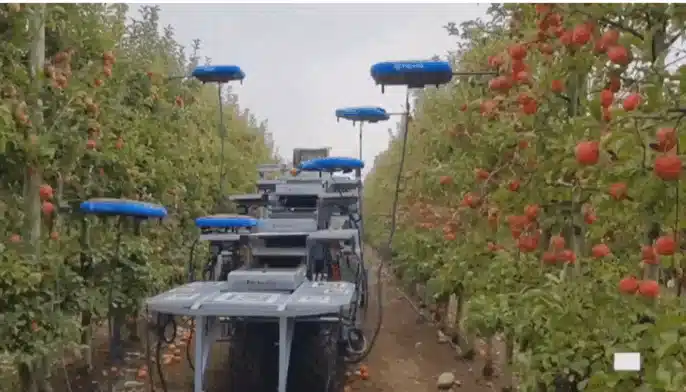Autonomous Aerial Robots: Harnessing Artificial Intelligence in Agriculture | AI in Farming | Drone Technology
Flying autonomous robot: Artificial Intelligence in Industry
Artificial Intelligence (AI) is transforming industries, notably including agriculture. A prime example is the autonomous aerial robot developed by Tevel Aerobotics Technologies, illustrating an innovative use of AI in apple harvesting.
Traditional apple farming methods, which ensure a steady supply of fresh and ripe apples, rely on extensive human labor. However, the advent of AI technology, specifically autonomous drones, has dramatically reduced the time and effort required, revolutionizing the apple harvesting process.
What features does an autonomous aerial robot possess?
These autonomous aerial robots or AI-powered drones, armed with advanced artificial intelligence capabilities, distinguish between ripe and unripe fruits - an essential feature for quality control in apple harvesting. The AI drone, tethered to a ground vehicle, maneuvers easily around the orchard, reaching hard-to-access spots on apple trees.

These agricultural drones are unique in design and function. They carefully pick ripe apples and place them on a QR-coded tarp, all the while minimizing damage to the trees and fruits.
Primary Advantages of AI-Powered Drones in Agriculture
The autonomous operation of these agricultural drones is one of their greatest benefits. The AI-enabled drones can operate 24/7, thus boosting apple harvesting productivity. With GPS integration and mobile app monitoring, farmers can keep track of drone operations, intervening if necessary.

AI in apple farming significantly reduces labor, saves time, and lowers costs. The AI drone, unlike human laborers, can work round-the-clock, significantly enhancing apple harvesting efficiency.
This advanced AI in agriculture also improves the precision of apple picking. Drone AI algorithms identify ripe apples based on various parameters like color and shape, reducing the risk of picking unripe or damaged apples.
Furthermore, these autonomous drones contribute to sustainable agriculture by optimizing waste reduction and maximizing yield per acre.

The use of AI in apple harvesting is just the start of a broader integration of AI into agriculture. As these technologies evolve, we can expect an increase in agricultural productivity, cost efficiency, and the adoption of more sustainable practices.
Conclusion
The autonomous aerial robot signifies a breakthrough in apple harvesting. With the power of artificial intelligence, this AI drone optimizes apple farming, delivering fresh, ripe apples to the market swiftly and efficiently. As a tool for sustainable agriculture, cost-effective farming, and increased productivity, AI in agriculture is set to revolutionize the farming industry. The future of farming is here, powered by artificial intelligence.


